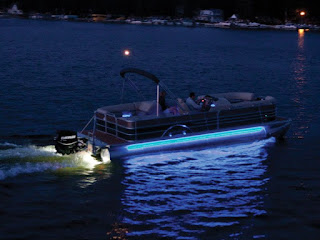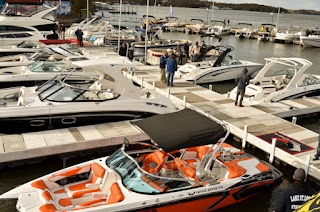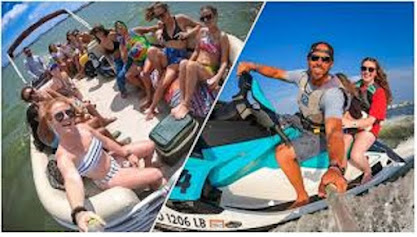Navigation and Recreational Lights at Night – The Good, The Bad, the Distracting - Author Capt. Glenn
Here at Lake of the Ozarks (and in fact all of Missouri’s
waterways and lakes), State Law requires the use of certain combinations of
lights (Red, Green, and White), called “Navigation Lights” when boating at
night. Missouri Law also regulates certain other styles of lights that boaters
use at night, called “Recreational Lighting”.
Recreational lighting on boats has become more popular in recent years. Recreational light can include Rub Rail lighting, Deck Rail lighting, or Underwater lighting. These can come in a variety of colors and intensities. The newest recreational lighting configurations use LED lights, which, by nature, are usually brighter than filament bulbs.
So, what’s the problem?
Well, there are a few; let’s discuss those.
First, USCG Regulations, Rule 20 again, states “The Rules concerning lights shall be complied with from sunset to sunrise, and during such times no other lights shall be exhibited, except such lights as cannot be mistaken for the lights specified in these Rules or do not impair their visibility or distinctive character, or interfere with the keeping of a proper look-out.”
What this means is, you cannot display any lights, other than navigation lights, that would either interfere with the boat operator’s ability to navigate at night, or would confuse or distract a boat operator from identifying another boat in their path. Notice that this does not differentiate between a boat underway, and an anchored boat.
Basically, the idea behind recreational lighting is “let’s party, and been seen doing it”. Recreational boat lighting is designed to be bright and visible. The problem with this is, it makes it difficult, or impossible, to see your boat’s navigation lights.
Per USCG Regulation Rules, your Red and Green navigation sidelights must be visible at a distance of at least one (1) mile in clear, dark conditions, and your masthead light must be visible in the same conditions at three (3) miles. If the USCG, or Missouri Water Patrol, were to observe your boat at night not meeting these visibility requirements, you can be stopped and ticketed.
For instance, if you installed rub rail lighting along the sides of your boat, were operating them at night, and were anchored. Another boat might not be able to see your anchor light due to the intensity of your rub rail lighting, and mistake your boat for a fixed shore object (a marina bar, for instance). At night, a person’s sense of distance and perspective are significantly diminished. Therefore, judgement of distances, and moving objects such as other boats is difficult.
Additionally, if recreational lighting is not installed correctly, the glare could impair the boat operator’s ability to see the surrounding water and navigate safely.
There are additional laws in Missouri regarding the use of lights on boats:
Some boats are equipped with Spot Lights, or Dock Lights. These may NOT be continuously operated while underway. They are only to be used for docking, or examining the surrounding water for floating hazards.
Also, flashing red and/or blue lights are prohibited on any vessel, except for authorized Public Safety vessels.
Finally, no recreational lighting may be displayed while a boat is underway. The Missouri Law states, in part: “All vessels shall display from sunset to sunrise proper navigational lights when under way, and during such time no other lights, continuous spotlights or docking lights, or other non-prescribed lights shall be exhibited.
If the boat is anchored, care must be taken so that other boats underway can still identify you as a boat.
Let’s take a look at both lighting categories, but first, a
bit of Regulatory baseline:
Since the Lake of the Ozarks is a Federally Managed
Waterway, the United States Coast Guard (USCG) regulates navigation on the
Lake, including the use of Navigation Lights. The International Regulations for Preventing Collisions at Sea
(or COLREGs) Rule 20
states, in part::
(a) Rules in this part shall be
complied with in all weathers.
(b) The Rules concerning lights
shall be complied with from sunset to sunrise, and during such times no other
lights shall be exhibited, except such lights as cannot be mistaken for the
lights specified in these Rules or do not impair their visibility or
distinctive character, or interfere with the keeping of a proper look-out.
(c) The lights prescribed by
these Rules shall, if carried, also be exhibited from sunrise to sunset in
restricted visibility and may be exhibited in all other circumstances when it
is deemed necessary.
In other words, a specific combination of lights must be used,
they must be used from sunset to sunrise (or in restricted visibility), and
other lights used must not be mistaken for Navigation Lights, or interfere with
a boat’s ability to navigate at night.
The State of Missouri has regulations (primarily Section 306.100
RSMo) that further regulate the use of Navigation Lights, and restrictions of
other types of lighting at night.
.Navigation Lights (night time or restricted visibility):
Combining the USCG and Missouri State laws, all power boats “under way” must display at least Red (port or left side) and Green (starboard or right side) “sidelights”, and a White, 360○ “all-around” light. Sometimes, the all-around White light is separated in to a mast-mounted Mastlight, which is visible from the front, and a stern-mounted Stern Light, which is only visible from the rear (astern).
The combined 360○ all-around light is the most
popular, and simplest, configuration for small pleasure boats.
The White all-around light must sit higher than the Reg/Green
sidelights.
Boats 26 feet in length and larger have additional requirements
for navigation lights; those may be found in Section 306.100 of the Revised
Statues of Missouri. Basically
additional white lights must be displayed.
Sailboats under way at night have slightly different lighting
requirements. They must display the
Red/Green sidelights, and a white Stern Light, but do not display a white 360○
all-around light. The sidelights and
stern light may be combined and displayed on the mast. In addition to the sidelights,
360○ all-around Red and Green masthead lights may be displayed as
shown below.
As a reminder, the Red/Green/White light combinations described above apply to powerboats or sailboats at night when underway. “Underway” means the boat is moving or floating, but not anchored. “Anchored” means that the boat is physically tied to something (a dock, pier, or mooring buoy). Fishing boats, for instance, that are stationary while fishing, are considered to be “underway” and must display all lights.
When a boat is anchored, it must show ONLY a White, 360○ “all-around” light. This applies equally to powerboats and
sailboats.
Boat manufactures conform to USCG regulations for type and
placement of Navigation Lights, so unless you’ve built a boat from scratch, the
boat you buy from a dealer/broker should conform to all applicable Federal and
State laws.
The same cannot be said for “Recreational” lighting. Be Seen and boat safe.





Comments
Post a Comment